I decided to make a LED grow light because it's a cheaper alternative to buying one and in this way I could choose light spectrum range. But most of all I knew that I would have fun assembling it. Before you start this project you should know that it is quite time consuming, that you will have to drill, solder and use digital multimeter. Since a LED light can consume hundreds of Watts of power, electric shock can be deadly. So DO NOT touch anything when the power is on and double check the circuit before turning the power on.
I used 87 3W LEDs so theoretically the light should consume 261W but in reality LEDs consume less then they are labeled for. For instance 3W red LED 660-670nm at 2.6V consumes 0.7A which is 1.82W. So my wannabe 261W light is actually something like 160W light. But you can use more LEDs if you want, two or three times as many. You can even use 5W or 10W LEDs instead of 3W but more powerful the LED, more heat per Watt it gives off so it's less efficient and the grow area needs more cooling. You shouldn't use less than 3W LEDs because the light of those LEDs is not bright enough.
Total cost for my LED light was 115 EUR (145 USD) but I had to buy only the LEDs and voltage regulators. Everything else I already had lying around my house.
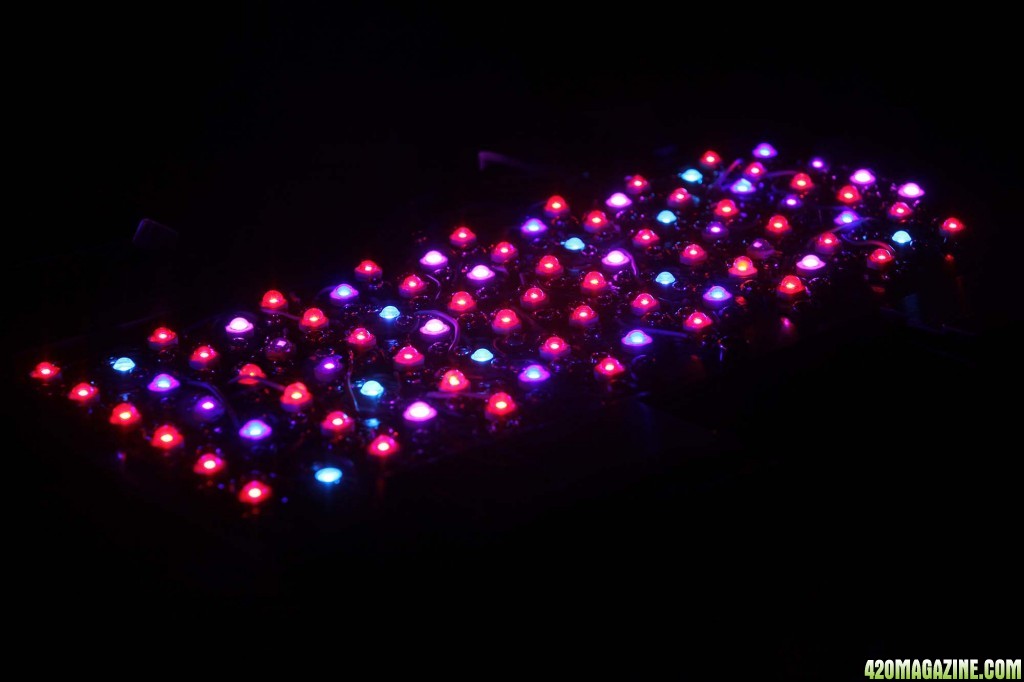
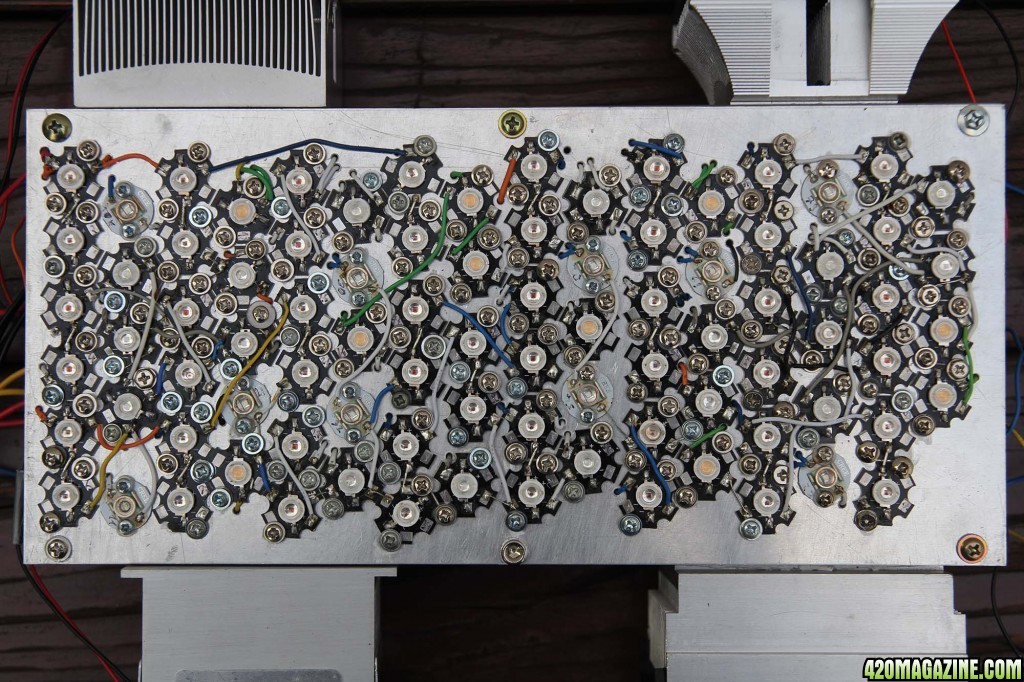
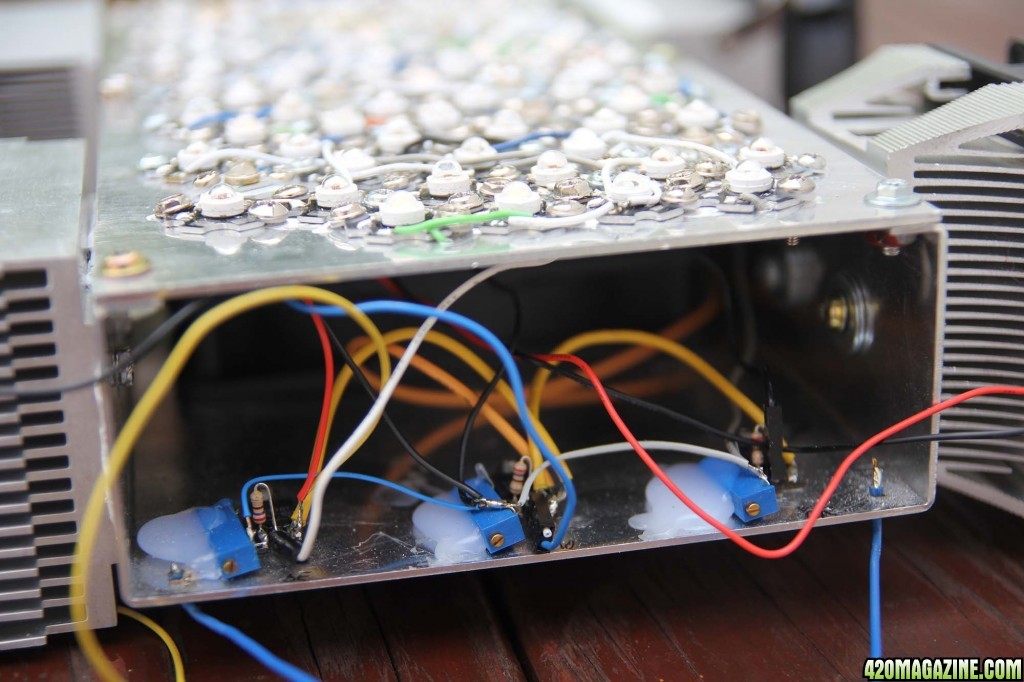
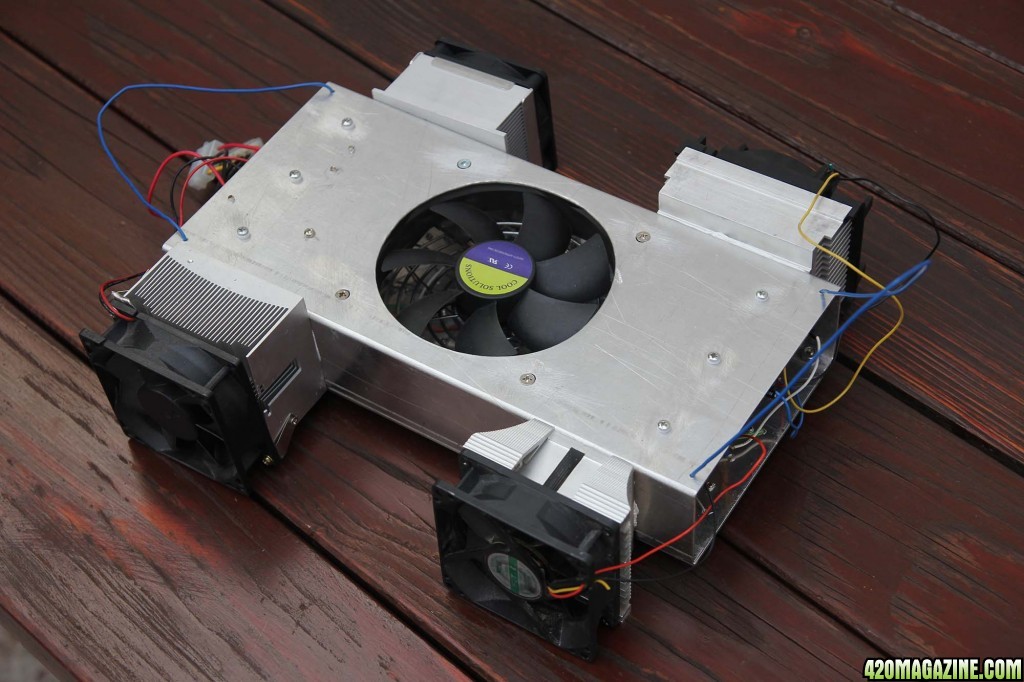
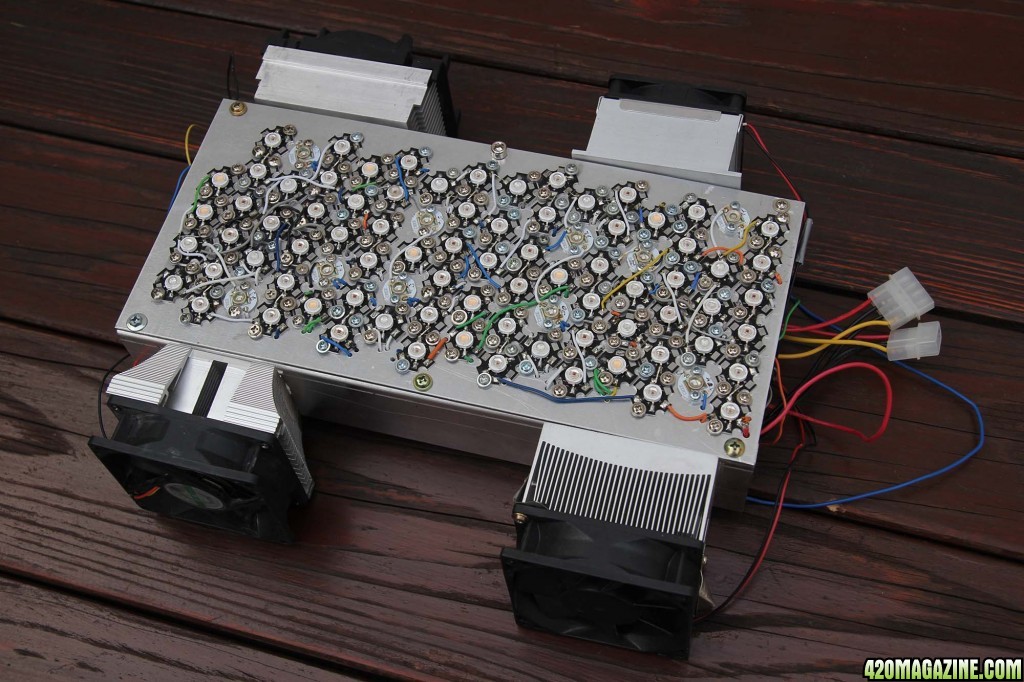
Tools you'll need:
- drill machine (preferably on the stand)
- 2.5, 3.5, 5 and 6 mm drills for metal (aluminum)
- M3 and M5 hand tap
- Soldering station with solder and flux
- Digital multimeter
- Round file for metal
- diagonal cutting pliers
- sand paper
- thermal paste
Materials you'll need:
- 3W LEDs on heatsinks (stars)
- LM338 (5A voltage regulator IC) with TO-220 mounting kit
- 220 ohm 0.25W resistor (one for each voltage regulator)
- 5 or 10 turn trimmer potentiometer 10K (one for each regulator)
- Aluminum housing
- M3 5-10 mm long screws with non conductive washer (2 for each LED)
- Some M3 and M4 nuts
- 10 M4 10 mm long screws
- 1 or 2 12 cm or14 cm PC fans with screws
- 4 PC CPU heatsinks with fans (Pentium 4 or any other square kind)
- PC PSU 350W or more
- 1 meter stranded copper wire for max 5A (different color for each LED type)
- Thicker wire for power supply, 20A, 3 different colors (read, yellow, black)
- 2 or more female Molex connectors (they come with Molex to SATA converter)
- 3 pin screw terminal
- Smaller screw terminal (for attaching wire to the LM338)
- toggle switches (optional if you want to disable individual wavelengths)
Which LEDs and how many
You should buy the LEDs already mounted on aluminum star heatsinks. I bought mine on eBay. They are probably not the best ones on the market but they've been working fine for more than two months now.
Which wavelength (light color) LEDs should you buy and how many? I am not an expert on this area but if you look at the chart below you can see which wavelengths are absorbed by the plant.
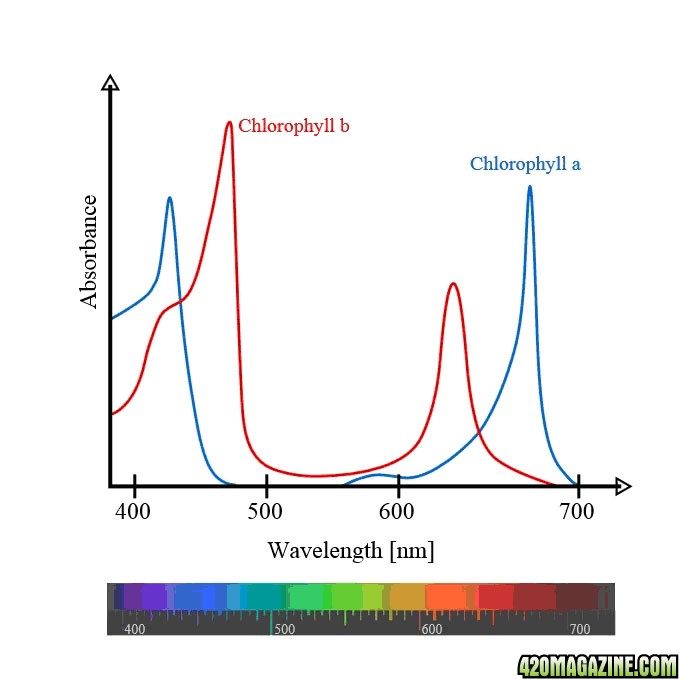
If you want to make a combined light for vegetative and flowering phase you should probably cower as much as possible from 380 to 700 nm with emphasis on the areas from 380 to 500 nm and from 600 to 700 nm. Since the plant in it's flowering phase needs more light, especially the red light spectrum, emphasis should be put on red spectrum LEDs. My choice was:
pieces color wavelength voltage
2 UV 380nm-385nm 3,6V-3,8V
5 UV 395nm-405nm 3,6V-4,2V
10 Purple 420nm-435nm 3,2V-3,6V
10 Royal Blue 440nm-460nm 3,0V-3,7V
10 Blue 470nm-475nm 3,2V-3,4V
20 Red 620nm-630nm 2,0V-2,6V
30 Red 660nm-670nm 2,2V-2,6V
What kind of Voltage regulation
The best choice would probably be a LED driver which limits the current to the LED so that it doesn't consume more and more power as it heats up more and more and than consequently frys itself. These drivers are quite expensive so I decided to use LM338 voltage regulator ICs. The problem with these regulators is that they only regulate voltage but not the current. That is why in this case your LED light will need a good cooling system. Not just for the LEDs so that they don't overheat and start consuming more power but especially for the voltage regulators because they produce quite a lot of heat.
LM338 voltage regulator is designed for 5A current and voltage can be precisely regulated. How many of these regulators you'll need depends on the type and number of LEDs you have. Let's say your LED consumes 0.7A at 2.6V. If you connect LM338 to 12V PSU you can set the voltage to 2.6V and power 7 LEDs in parallel. That is 7*0.7A=4.9A at 2.6V.
Or you can set the voltage twice as high (5.2V) and connect 14 LEDs but in this case 7 sequentially connected pairs in parallel.
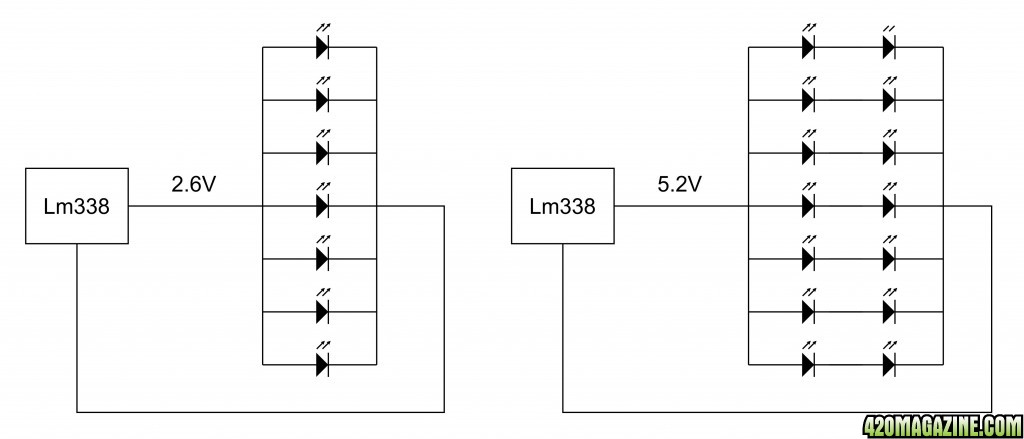
If you adjust the voltage to 7.8V 21 LEDs can be connected and so on. But remember LM338 regulators can adjust the output voltage only up to something like 2V lower than the input voltage, so I'm not sure if connecting 28 such LEDs to single LM338 at input voltage of 12V would work.
In this way — according to the number of the same type of LEDs and their operating voltage — you have to calculate how many voltage regulators you need and how the LEDs are going to be connected. I think it'snot wise to connect the LED to its maximum voltage. I would suggest 0.1V lower than the LED's maximum voltage. So if the LED is labeled for 2.4V-2.6V I would suggest you give it not more than 2.5V.
Another important thing is that from PC PSU we don't get only 12V to work with. We also get 5V and 3.3V which can be used without the voltage regulators. But you have to be careful that you don't exceed the load on the PSU. If you look at the PSU there is a label on it that tells you how much current each line can deliver and you must not overload it. For instance, I have a 430W PSU which can deliver 34A at 5V and 15A at 12V. If you need more power you need two PSUs or a more powerful one.
The housing
The housing should be custom made from 1.5 mm thick aluminum plate. The bigger the housing the better, since it means better heat dispensation and a larger area of the grow room can be better covered with bigger light. LEDs are suppose to spread light in 120 degrees angle but in reality the area that is not directly under the light receives much less light. In case of my grow closet which is 90 x 60 cm (3' x 2') the corners receive only half as much light as the area directly under the light. But major factor in deciding how large should the housing be is the number of LEDs you want to use. If I would make a LED light again the housing would be 45 x 25 cm and the LEDs would be more apart than they are on my existing light. They would be spaced like this.
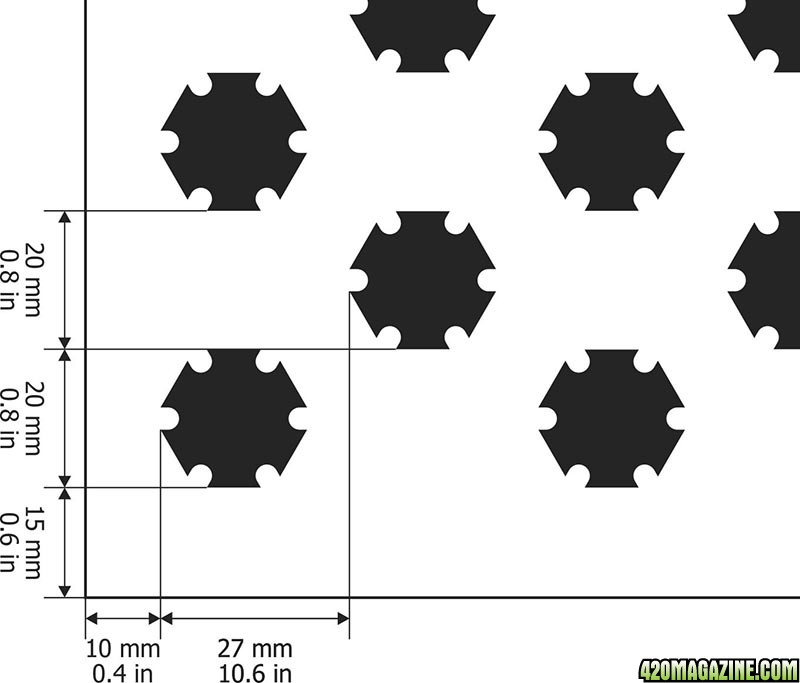
You can ask anybody who has the equipment for bending and cutting metal plates to make the housing for you. This is the housing blueprint:
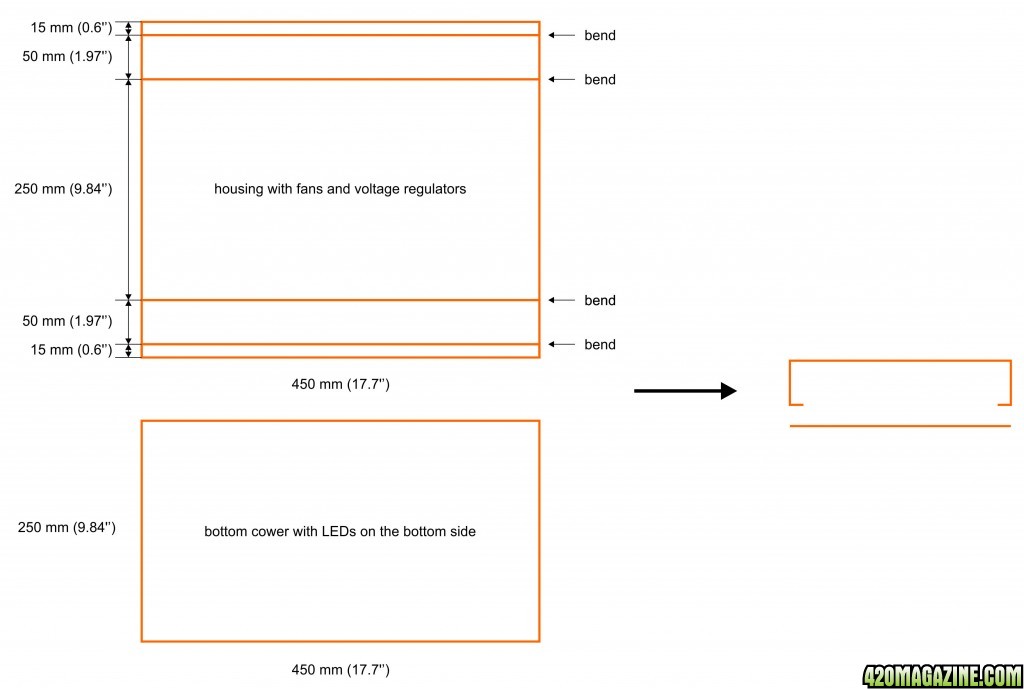
Additional work on the housing
When your housing is ready you should drill the holes for the fans, voltage regulators, screw terminals, switches and for attaching the bottom plate with the housing.
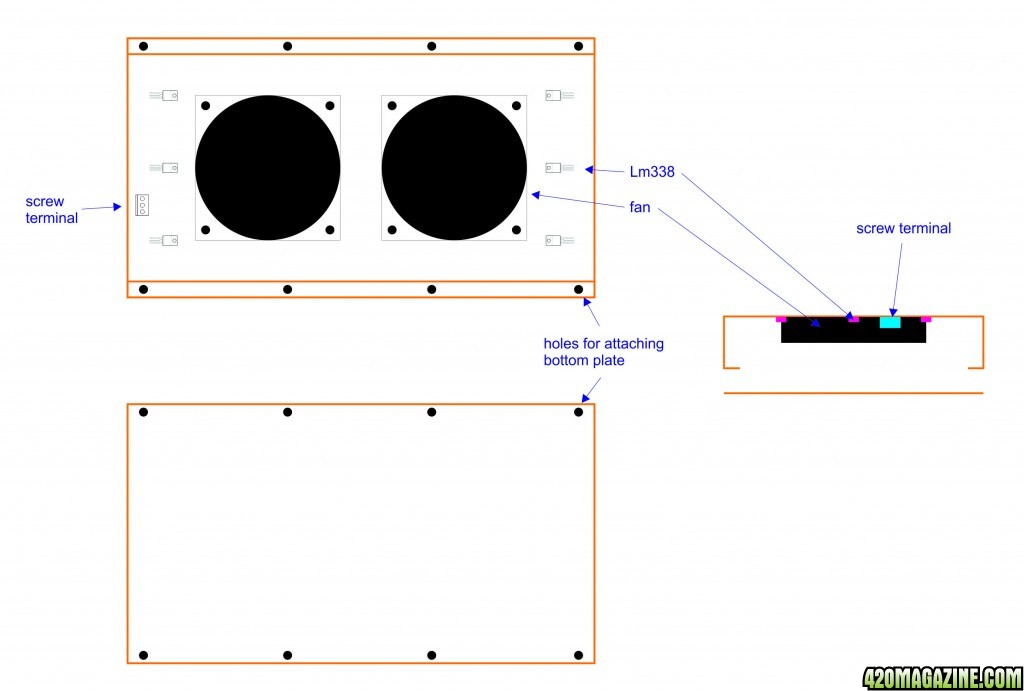
Place your fans on the top of the housing approximately as shown in the image above. Mark where the holes for the fan attachment screws should be drilled. Mark where the circular opening for the fan should be cut out. Now drill the holes for the fans with 5 mm drill. After you drill the hole in the aluminum plate you should always clean it's edge with sand paper. Now you have to cut out the fan openings. I did that by drilling 5 mm holes one next to the other close to the inside edge of the circle that marked the opening. Than I cut the remaining aluminum bridges between the holes with diagonal cutting pliers and removed the plate. I removed the excess aluminum with round file and smoothed the edge of the opening with sand paper.
Now mark on the bottom plate where the 8 holes will be drilled. These markers should be 8 mm from the edge of the plate. Drill 5 mm holes and place the bottom plate on the housing. Use the duct tape or something like that to fix it so it will not move when drilling the holes in the housing which is the next step.
Place the voltage controllers according to the image above and mark the holes. Check the diameter of your TO-220 mount kit insulator (usually 3.5 mm) and use proper drill to drill the holes. Clean the edges with precision.
If you want to use switches to disable individual wavelengths you should drill holes for them. I suggest you put them somewhere near the voltage regulators. The best place would be between the regulators and 14 cm fan but you have to set apart some space for them before you position the regulators and the fans.
Drill suitable holes for screw terminal which should be placed between two voltage regulators and near the edge of the housing.
3 cm from screw terminal to the inside of the housing you should drill 2.5 mm hole and make a screw thread with M3 hand tap. In this hole you should screw 2 cm long M3 bolt. Firmly attach it to the housing with nut and screw some additional nuts on it. This bolt will connect ground wiring with the housing. Find a copper wire as thick as possible that will still fit in terminal and peal off a few centimeters of insulation. If the wire is stranded cover it with solder. Insert one end of the wire in the terminal and wind the other end once round the ground bolt. The wire should be strained. Now all the ground wiring from fans and voltage regulators can be soldered to this wire or nutted to the bolt.
Now you should position 4 CPU heatsinks on the side of the housing. Two on each side next to the shortest edge. Drill two 4 mm holes in the housing for each heatsink a few cm apart. Clean the edges of the holes and place the heatsink on its position. mark the position of the holes on the heatsink From the inside of the housing with precision. Drill 4 mm holes in the heatsink at least 7 mm deep and than use M5 hand tap to make a screw thread. Use the hand tap on the heatsink holes in the housing also or widen them with 5 mm drill. Clean the holes so the heatsink fits well to the housing. Do that for all 4 heatsinks and than attach them to the housing with M5 screws. Use a thermal paste.
Attach 14 cm fans, mind the rotation direction. The fans should blow air inside the housing and cool the bottom panel in this way.
Attach voltage regulators. Use TO-220 mounting kit.
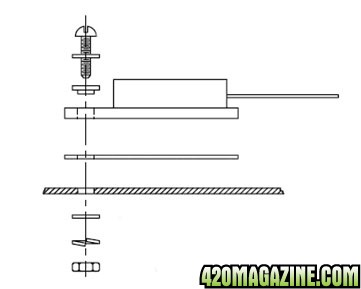
When all the regulators are mounted use a multimeter to check and make sure that Vout of the regulator (middle lead and metal plate of the IC) and aluminum housing ARE NOT shorted. If they are shorted remount the regulator and check again for short. The housing will be connected to the ground that is why there must not be a short between the Vout of the regulator and the housing.
Preparing the power supply unit
As a power supply we are going to use PC PSU (Power Supply Unit). To make it operate outside the PC we need to convert it a little. The PSU must be unplugged. Firstly cut off all the connectors except the Molexs you need. Molex is a power connector with four wires (2 black, yellow and red) which is used for older disk drives and CD/DVD drives. Do not cut the wires off yet. Now take the green one and one black wire and shorten them to approximately 10 cm. Solder them together and insulate the connection with heat-shrink tube. If you want a remote switch to turn the PSU on and off you can connect the switch to those wires.
Now you can cut off all the other wires except those connected to the Molexs you need.
If the wires to the Molexs are too short for your needs you can extend them with thick 20A wires preferable in three different colors. Solder them and protect the joints with heat-shrink tube or use screw terminals.
Connecting the voltage regulators
Take two Molex to SATA converters or three if your LED light is in reality going to consume more than 300W and cut of the SATA connectors.
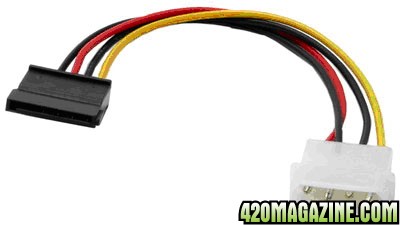
Connect all the wires of all female Molexs to the screw terminal on your housing. Connect all black wires to the ground copper wire which is connected to the ground bolt, all red wires to the second hole of the terminal and all yellow wires to the last hole. Remember: red is 5V wire, yellow is 12V wire and black is the ground.
Now you should connect the resistors and wires to the voltage regulators. I did this according to the image below. On the right side is the image of how should things actually be put together.
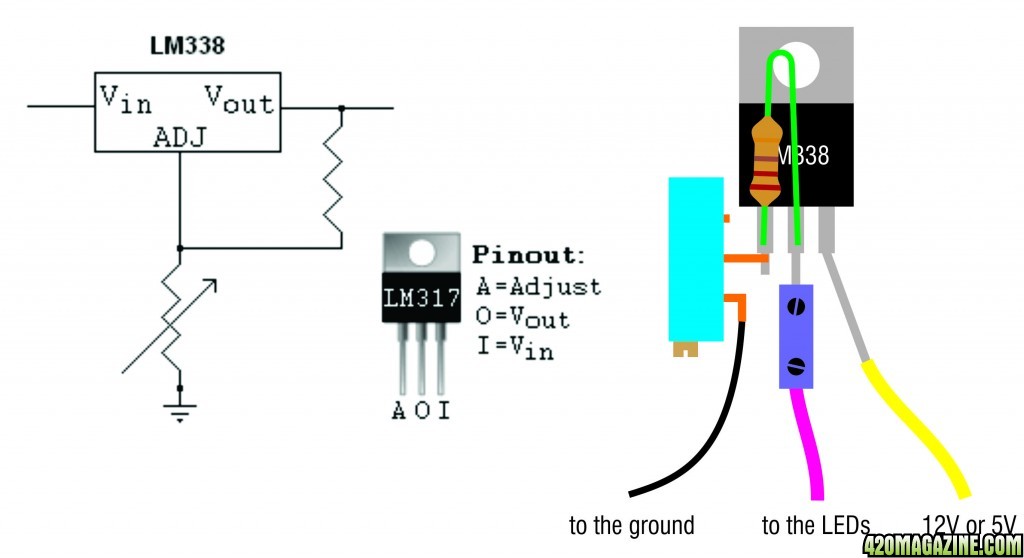
Take the 220 ohm resistor and bend one of it's connectors close to the body as shown on the image above. Shorten both of the connectors and solder the resistor close to the LM338's body. The resistor should be perpendicular to the IC.
Take trimmer potentiometer and cut off the pin which is furtherest from the screw. Shorten the middle pin if necessary, solder it to the Adjust pin of the IC and cut off it's excess. Press gently on the trimmer so it is close to the aluminum housing and fix it with some kind of glue. I used the hot glue gun. Now connect the third trimmer pin to the ground wire. You can use ordinary thin wire. Than solder thicker 5A wire to the Vin of the IC and insulate the joint with heat shrinking tube. You can use the yellow or red wire which you earlier cut off from the PSU. Connect the other end of the wire to 12V or 5V terminal. It will usually be 12V because 5V can be ideally used without the voltage regulators to power sequentially connected pairs of red LEDs which consume 2V-2.6V so 2x2.5V=5V. If you installed switches to disable groups of LEDs you should lead 12V to the switch first and than from the switch to the Vin of the IC.
Find some 5A wire to connect it to Vout of the IC. Connect it with small screw terminal so you can easily remove it in case you will have to remove the bottom LED panel for repair or whatever. It can be PSU wire but it should be long enough that it can connect the housing with the LED panel even if the panel is placed next to the housing and not attached to it.
Now it is time to power on the PSU and set the voltage. Measure the Vout with multimeter and adjust the trimmer potentiometer screw until the desired voltage is displayed.
Power for each voltage regulator must be brought directly from 12V terminal NOT from neighboring regulator. They must all be powered in parallel.
Fixing the LEDs
Now you have to fix the LEDs to the panel. LEDs with different wavelengths should be evenly arranged across the panel so the light will be as homogeneous as possible. But you have to consider how you will connect the LEDs. If they will be connected in sequence it is logical that they are close to each other so the connections can be as short as possible.
I arranged my LEDs like this but I am sure that there are better possibilities.
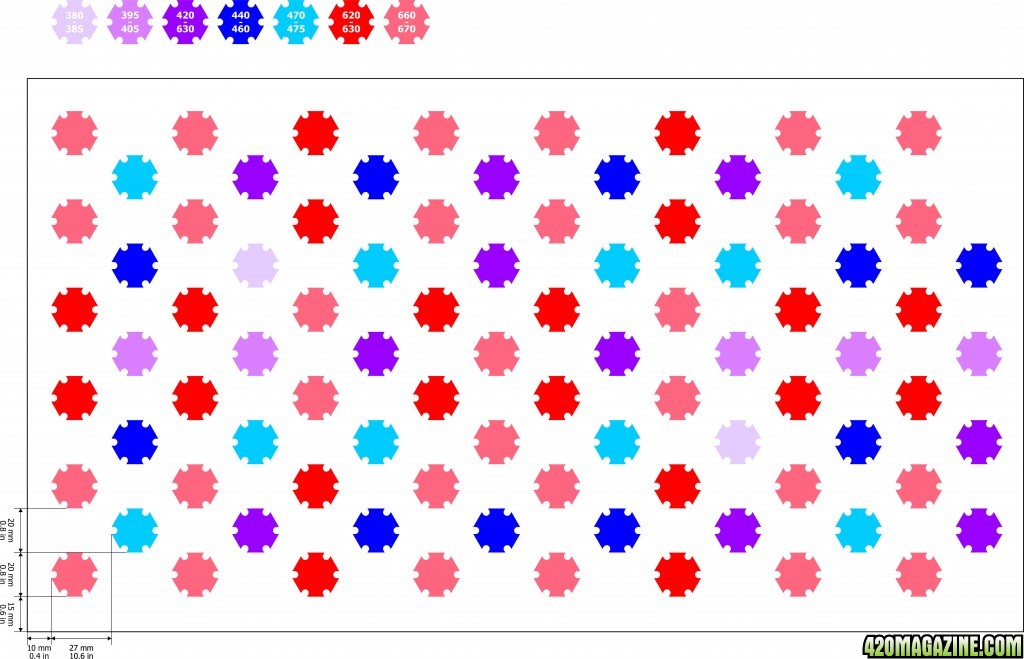
Each LED star should be checked with multimeter for short between the aluminum star heatsink and positive lead. That is very important because some Chinese LEDs are poor in quality and short is a possibility. In my case majority of 440 nm LEDs had a short. If there is a short you can file of a little of the star's edge where the positive lead is next to it. If there is no short position the star and mark where the holes are going to be. Each star should be fixed with two M3 screws. You can use 2.5 mm drill and make a screw thread with M3 hand tap. But since the aluminum panel is only 1.5 mm thick the screw treads usually do not hold strong enough so in this case a nut can be used. Always place an insulating washer between the star and a screw so that the positive lead does not become shorted with the ground when the screw is in place. You can use a thermal paste but it is not necessary. When all the stars are fixed you can start wiring them. Start with groups with smaller number of LEDs so you can learn how to do it as you go along.
Each star needs additional hole or two for wiring. It depends on how they are connected together. Negative leads of more neighboring LEDs can be connected together and to one of the star fixing screws if it is next to a negative lead. If the wires that connect the LEDs are short you can lead them between the LEDs but if they are longer it is better to lead them across the other side of the panel (where there are no LEDs). Always keep the wires as short as possible so they will not mess up or block the light.
When all the LEDs in the group are connected to each other, to the ground and the power source do not turn the power on until you double check all the connections with multimeter (resistance or sound signal for short). Mind that when the LEDs are connected in sequence the first LED's negative lead must not be connected to the ground but to the positive lead of the sequential LED. If everything is connected as it should be and if the voltage is set as it should be you can turn on the PSU and observe your brilliant achievement.
When all the LEDs are connected and are working fine you should connect the fans. Connect all the positive leads of the fans to 12V terminal and ground leads to the ground wire.
Tie loose wires with cable ties so they won't mess with the fans.
Screw the LED panel to the housing.
Before installing the LED light it must be turned on for three hours and you must regularly check it for overheating. In the beginning turn it off every 5 and than every 10 minutes and touch different parts of the housing — especially where the voltage regulators are — and the wires. Later check it every half an hour. DO NOT touch it when it is turned on. When you touch it it can be worm, but no hot. No more than 50 degrees Celsius (122 F).
Enjoy the harvest.
I used 87 3W LEDs so theoretically the light should consume 261W but in reality LEDs consume less then they are labeled for. For instance 3W red LED 660-670nm at 2.6V consumes 0.7A which is 1.82W. So my wannabe 261W light is actually something like 160W light. But you can use more LEDs if you want, two or three times as many. You can even use 5W or 10W LEDs instead of 3W but more powerful the LED, more heat per Watt it gives off so it's less efficient and the grow area needs more cooling. You shouldn't use less than 3W LEDs because the light of those LEDs is not bright enough.
Total cost for my LED light was 115 EUR (145 USD) but I had to buy only the LEDs and voltage regulators. Everything else I already had lying around my house.
Tools you'll need:
- drill machine (preferably on the stand)
- 2.5, 3.5, 5 and 6 mm drills for metal (aluminum)
- M3 and M5 hand tap
- Soldering station with solder and flux
- Digital multimeter
- Round file for metal
- diagonal cutting pliers
- sand paper
- thermal paste
Materials you'll need:
- 3W LEDs on heatsinks (stars)
- LM338 (5A voltage regulator IC) with TO-220 mounting kit
- 220 ohm 0.25W resistor (one for each voltage regulator)
- 5 or 10 turn trimmer potentiometer 10K (one for each regulator)
- Aluminum housing
- M3 5-10 mm long screws with non conductive washer (2 for each LED)
- Some M3 and M4 nuts
- 10 M4 10 mm long screws
- 1 or 2 12 cm or14 cm PC fans with screws
- 4 PC CPU heatsinks with fans (Pentium 4 or any other square kind)
- PC PSU 350W or more
- 1 meter stranded copper wire for max 5A (different color for each LED type)
- Thicker wire for power supply, 20A, 3 different colors (read, yellow, black)
- 2 or more female Molex connectors (they come with Molex to SATA converter)
- 3 pin screw terminal
- Smaller screw terminal (for attaching wire to the LM338)
- toggle switches (optional if you want to disable individual wavelengths)
Which LEDs and how many
You should buy the LEDs already mounted on aluminum star heatsinks. I bought mine on eBay. They are probably not the best ones on the market but they've been working fine for more than two months now.
Which wavelength (light color) LEDs should you buy and how many? I am not an expert on this area but if you look at the chart below you can see which wavelengths are absorbed by the plant.

If you want to make a combined light for vegetative and flowering phase you should probably cower as much as possible from 380 to 700 nm with emphasis on the areas from 380 to 500 nm and from 600 to 700 nm. Since the plant in it's flowering phase needs more light, especially the red light spectrum, emphasis should be put on red spectrum LEDs. My choice was:
pieces color wavelength voltage
2 UV 380nm-385nm 3,6V-3,8V
5 UV 395nm-405nm 3,6V-4,2V
10 Purple 420nm-435nm 3,2V-3,6V
10 Royal Blue 440nm-460nm 3,0V-3,7V
10 Blue 470nm-475nm 3,2V-3,4V
20 Red 620nm-630nm 2,0V-2,6V
30 Red 660nm-670nm 2,2V-2,6V
What kind of Voltage regulation
The best choice would probably be a LED driver which limits the current to the LED so that it doesn't consume more and more power as it heats up more and more and than consequently frys itself. These drivers are quite expensive so I decided to use LM338 voltage regulator ICs. The problem with these regulators is that they only regulate voltage but not the current. That is why in this case your LED light will need a good cooling system. Not just for the LEDs so that they don't overheat and start consuming more power but especially for the voltage regulators because they produce quite a lot of heat.
LM338 voltage regulator is designed for 5A current and voltage can be precisely regulated. How many of these regulators you'll need depends on the type and number of LEDs you have. Let's say your LED consumes 0.7A at 2.6V. If you connect LM338 to 12V PSU you can set the voltage to 2.6V and power 7 LEDs in parallel. That is 7*0.7A=4.9A at 2.6V.
Or you can set the voltage twice as high (5.2V) and connect 14 LEDs but in this case 7 sequentially connected pairs in parallel.

If you adjust the voltage to 7.8V 21 LEDs can be connected and so on. But remember LM338 regulators can adjust the output voltage only up to something like 2V lower than the input voltage, so I'm not sure if connecting 28 such LEDs to single LM338 at input voltage of 12V would work.
In this way — according to the number of the same type of LEDs and their operating voltage — you have to calculate how many voltage regulators you need and how the LEDs are going to be connected. I think it'snot wise to connect the LED to its maximum voltage. I would suggest 0.1V lower than the LED's maximum voltage. So if the LED is labeled for 2.4V-2.6V I would suggest you give it not more than 2.5V.
Another important thing is that from PC PSU we don't get only 12V to work with. We also get 5V and 3.3V which can be used without the voltage regulators. But you have to be careful that you don't exceed the load on the PSU. If you look at the PSU there is a label on it that tells you how much current each line can deliver and you must not overload it. For instance, I have a 430W PSU which can deliver 34A at 5V and 15A at 12V. If you need more power you need two PSUs or a more powerful one.
The housing
The housing should be custom made from 1.5 mm thick aluminum plate. The bigger the housing the better, since it means better heat dispensation and a larger area of the grow room can be better covered with bigger light. LEDs are suppose to spread light in 120 degrees angle but in reality the area that is not directly under the light receives much less light. In case of my grow closet which is 90 x 60 cm (3' x 2') the corners receive only half as much light as the area directly under the light. But major factor in deciding how large should the housing be is the number of LEDs you want to use. If I would make a LED light again the housing would be 45 x 25 cm and the LEDs would be more apart than they are on my existing light. They would be spaced like this.

You can ask anybody who has the equipment for bending and cutting metal plates to make the housing for you. This is the housing blueprint:

Additional work on the housing
When your housing is ready you should drill the holes for the fans, voltage regulators, screw terminals, switches and for attaching the bottom plate with the housing.

Place your fans on the top of the housing approximately as shown in the image above. Mark where the holes for the fan attachment screws should be drilled. Mark where the circular opening for the fan should be cut out. Now drill the holes for the fans with 5 mm drill. After you drill the hole in the aluminum plate you should always clean it's edge with sand paper. Now you have to cut out the fan openings. I did that by drilling 5 mm holes one next to the other close to the inside edge of the circle that marked the opening. Than I cut the remaining aluminum bridges between the holes with diagonal cutting pliers and removed the plate. I removed the excess aluminum with round file and smoothed the edge of the opening with sand paper.
Now mark on the bottom plate where the 8 holes will be drilled. These markers should be 8 mm from the edge of the plate. Drill 5 mm holes and place the bottom plate on the housing. Use the duct tape or something like that to fix it so it will not move when drilling the holes in the housing which is the next step.
Place the voltage controllers according to the image above and mark the holes. Check the diameter of your TO-220 mount kit insulator (usually 3.5 mm) and use proper drill to drill the holes. Clean the edges with precision.
If you want to use switches to disable individual wavelengths you should drill holes for them. I suggest you put them somewhere near the voltage regulators. The best place would be between the regulators and 14 cm fan but you have to set apart some space for them before you position the regulators and the fans.
Drill suitable holes for screw terminal which should be placed between two voltage regulators and near the edge of the housing.
3 cm from screw terminal to the inside of the housing you should drill 2.5 mm hole and make a screw thread with M3 hand tap. In this hole you should screw 2 cm long M3 bolt. Firmly attach it to the housing with nut and screw some additional nuts on it. This bolt will connect ground wiring with the housing. Find a copper wire as thick as possible that will still fit in terminal and peal off a few centimeters of insulation. If the wire is stranded cover it with solder. Insert one end of the wire in the terminal and wind the other end once round the ground bolt. The wire should be strained. Now all the ground wiring from fans and voltage regulators can be soldered to this wire or nutted to the bolt.
Now you should position 4 CPU heatsinks on the side of the housing. Two on each side next to the shortest edge. Drill two 4 mm holes in the housing for each heatsink a few cm apart. Clean the edges of the holes and place the heatsink on its position. mark the position of the holes on the heatsink From the inside of the housing with precision. Drill 4 mm holes in the heatsink at least 7 mm deep and than use M5 hand tap to make a screw thread. Use the hand tap on the heatsink holes in the housing also or widen them with 5 mm drill. Clean the holes so the heatsink fits well to the housing. Do that for all 4 heatsinks and than attach them to the housing with M5 screws. Use a thermal paste.
Attach 14 cm fans, mind the rotation direction. The fans should blow air inside the housing and cool the bottom panel in this way.
Attach voltage regulators. Use TO-220 mounting kit.

When all the regulators are mounted use a multimeter to check and make sure that Vout of the regulator (middle lead and metal plate of the IC) and aluminum housing ARE NOT shorted. If they are shorted remount the regulator and check again for short. The housing will be connected to the ground that is why there must not be a short between the Vout of the regulator and the housing.
Preparing the power supply unit
As a power supply we are going to use PC PSU (Power Supply Unit). To make it operate outside the PC we need to convert it a little. The PSU must be unplugged. Firstly cut off all the connectors except the Molexs you need. Molex is a power connector with four wires (2 black, yellow and red) which is used for older disk drives and CD/DVD drives. Do not cut the wires off yet. Now take the green one and one black wire and shorten them to approximately 10 cm. Solder them together and insulate the connection with heat-shrink tube. If you want a remote switch to turn the PSU on and off you can connect the switch to those wires.
Now you can cut off all the other wires except those connected to the Molexs you need.
If the wires to the Molexs are too short for your needs you can extend them with thick 20A wires preferable in three different colors. Solder them and protect the joints with heat-shrink tube or use screw terminals.
Connecting the voltage regulators
Take two Molex to SATA converters or three if your LED light is in reality going to consume more than 300W and cut of the SATA connectors.

Connect all the wires of all female Molexs to the screw terminal on your housing. Connect all black wires to the ground copper wire which is connected to the ground bolt, all red wires to the second hole of the terminal and all yellow wires to the last hole. Remember: red is 5V wire, yellow is 12V wire and black is the ground.
Now you should connect the resistors and wires to the voltage regulators. I did this according to the image below. On the right side is the image of how should things actually be put together.

Take the 220 ohm resistor and bend one of it's connectors close to the body as shown on the image above. Shorten both of the connectors and solder the resistor close to the LM338's body. The resistor should be perpendicular to the IC.
Take trimmer potentiometer and cut off the pin which is furtherest from the screw. Shorten the middle pin if necessary, solder it to the Adjust pin of the IC and cut off it's excess. Press gently on the trimmer so it is close to the aluminum housing and fix it with some kind of glue. I used the hot glue gun. Now connect the third trimmer pin to the ground wire. You can use ordinary thin wire. Than solder thicker 5A wire to the Vin of the IC and insulate the joint with heat shrinking tube. You can use the yellow or red wire which you earlier cut off from the PSU. Connect the other end of the wire to 12V or 5V terminal. It will usually be 12V because 5V can be ideally used without the voltage regulators to power sequentially connected pairs of red LEDs which consume 2V-2.6V so 2x2.5V=5V. If you installed switches to disable groups of LEDs you should lead 12V to the switch first and than from the switch to the Vin of the IC.
Find some 5A wire to connect it to Vout of the IC. Connect it with small screw terminal so you can easily remove it in case you will have to remove the bottom LED panel for repair or whatever. It can be PSU wire but it should be long enough that it can connect the housing with the LED panel even if the panel is placed next to the housing and not attached to it.
Now it is time to power on the PSU and set the voltage. Measure the Vout with multimeter and adjust the trimmer potentiometer screw until the desired voltage is displayed.
Power for each voltage regulator must be brought directly from 12V terminal NOT from neighboring regulator. They must all be powered in parallel.
Fixing the LEDs
Now you have to fix the LEDs to the panel. LEDs with different wavelengths should be evenly arranged across the panel so the light will be as homogeneous as possible. But you have to consider how you will connect the LEDs. If they will be connected in sequence it is logical that they are close to each other so the connections can be as short as possible.
I arranged my LEDs like this but I am sure that there are better possibilities.

Each LED star should be checked with multimeter for short between the aluminum star heatsink and positive lead. That is very important because some Chinese LEDs are poor in quality and short is a possibility. In my case majority of 440 nm LEDs had a short. If there is a short you can file of a little of the star's edge where the positive lead is next to it. If there is no short position the star and mark where the holes are going to be. Each star should be fixed with two M3 screws. You can use 2.5 mm drill and make a screw thread with M3 hand tap. But since the aluminum panel is only 1.5 mm thick the screw treads usually do not hold strong enough so in this case a nut can be used. Always place an insulating washer between the star and a screw so that the positive lead does not become shorted with the ground when the screw is in place. You can use a thermal paste but it is not necessary. When all the stars are fixed you can start wiring them. Start with groups with smaller number of LEDs so you can learn how to do it as you go along.
Each star needs additional hole or two for wiring. It depends on how they are connected together. Negative leads of more neighboring LEDs can be connected together and to one of the star fixing screws if it is next to a negative lead. If the wires that connect the LEDs are short you can lead them between the LEDs but if they are longer it is better to lead them across the other side of the panel (where there are no LEDs). Always keep the wires as short as possible so they will not mess up or block the light.
When all the LEDs in the group are connected to each other, to the ground and the power source do not turn the power on until you double check all the connections with multimeter (resistance or sound signal for short). Mind that when the LEDs are connected in sequence the first LED's negative lead must not be connected to the ground but to the positive lead of the sequential LED. If everything is connected as it should be and if the voltage is set as it should be you can turn on the PSU and observe your brilliant achievement.
When all the LEDs are connected and are working fine you should connect the fans. Connect all the positive leads of the fans to 12V terminal and ground leads to the ground wire.
Tie loose wires with cable ties so they won't mess with the fans.
Screw the LED panel to the housing.
Before installing the LED light it must be turned on for three hours and you must regularly check it for overheating. In the beginning turn it off every 5 and than every 10 minutes and touch different parts of the housing — especially where the voltage regulators are — and the wires. Later check it every half an hour. DO NOT touch it when it is turned on. When you touch it it can be worm, but no hot. No more than 50 degrees Celsius (122 F).
Enjoy the harvest.



